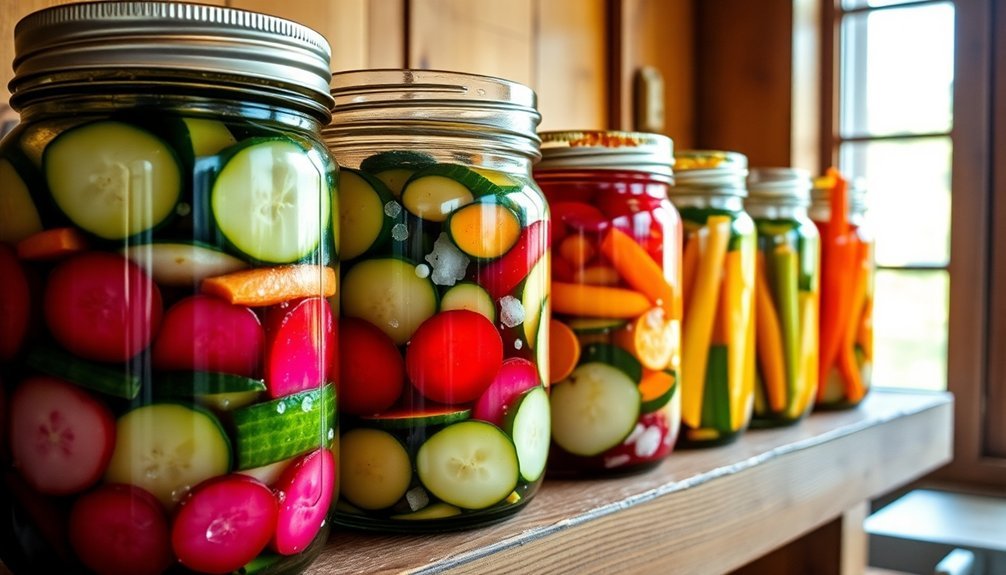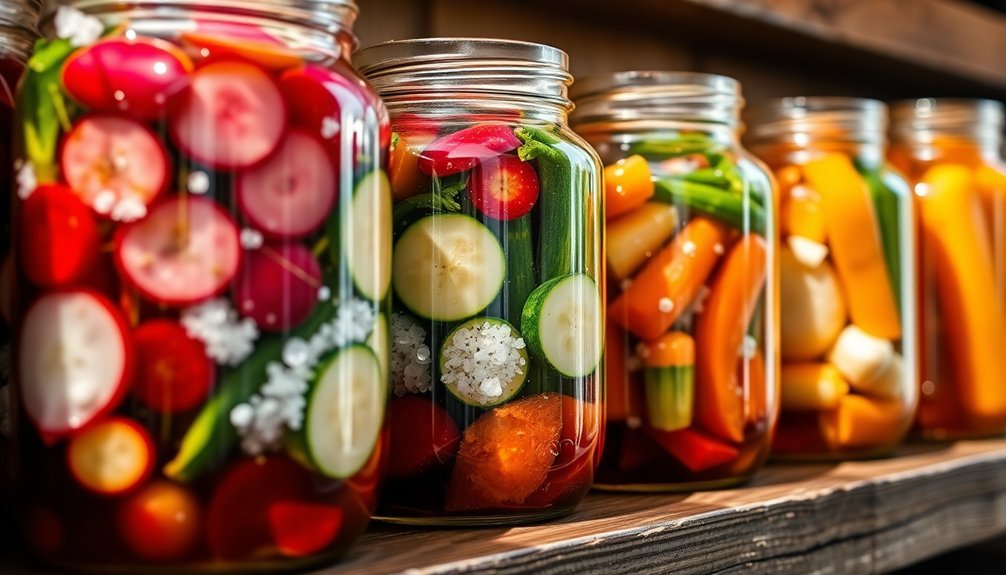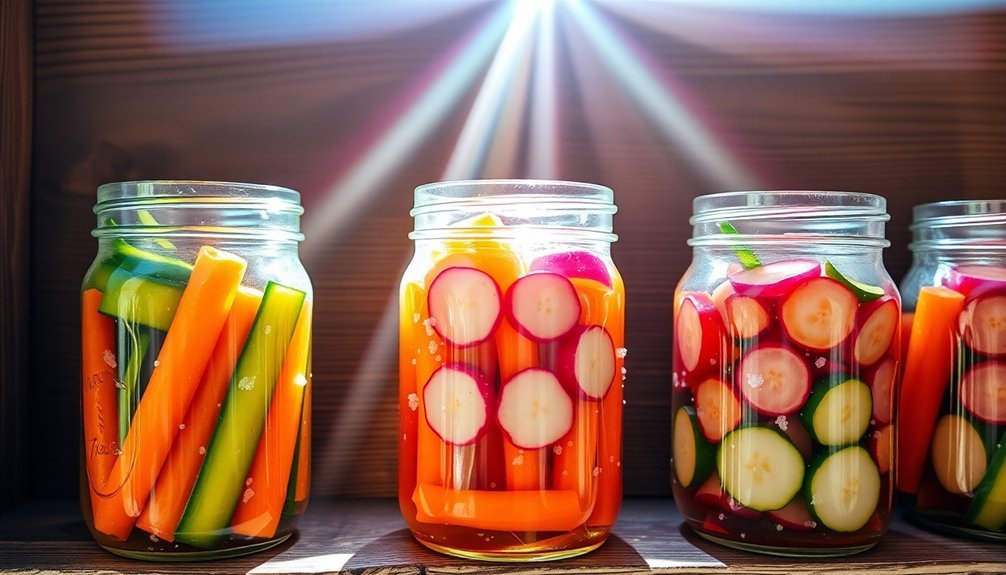Salt-cured vegetables can last anywhere from 4-8 months when properly preserved and stored. You'll get the best results by keeping them at temperatures between 32-40°F (0-4.4°C) with humidity around 95%. The salt concentration you use matters – 2-5% works for fermentation while 20-25% is ideal for longer preservation. Your veggies should stay firm and vibrant, with any soft spots indicating spoilage. Root vegetables like carrots and potatoes tend to last the longest, especially when stored in clean mason jars or proper containers. There's much more to mastering the art of salt preservation than just the basics.
Understanding Salt Curing Basics

Salt preservation mastery begins with understanding two key concentration levels: low (2.5-5%) and high (20-25%). When you're working with low concentrations, you'll create an environment perfect for fermentation, allowing beneficial lactic acid bacteria to thrive and produce tangy, flavorful results.
High concentrations, on the other hand, prevent all bacterial growth and focus on pure preservation. For optimal results, prepare in mild weather conditions.
The magic of salt curing happens through moisture extraction. As salt draws water from your vegetables, it creates a brine that's naturally inhospitable to harmful bacteria. You'll notice this process enhances flavors while maintaining the vegetables' signature crunch and texture.
You can apply salt preservation to a wide variety of vegetables using two main techniques. Dry salting works best for finely chopped, water-rich vegetables, while brining suits larger pieces or vegetables with lower water content.
Before starting, you'll need to contemplate whether your vegetables require preparatory steps like blanching or drying.
The preservation mechanism relies on salt's ability to inhibit spoilage-causing bacteria while creating an anaerobic environment. When done correctly, you're not just preserving food – you're developing complex, savory flavors that improve over time.
Optimal Storage Conditions
Creating the perfect storage environment for your salt-cured vegetables requires careful attention to temperature, humidity, and ventilation.
You'll need to maintain temperatures between 32-40°F (0-4.4°C) for most vegetables, though some varieties like cucumbers and pumpkins need slightly warmer conditions. Don't let temperatures drop below freezing or rise above 50°F, as this can compromise quality. Shelf life typically decreases by 25% with each 10°F increase in temperature.
Keep humidity levels around 95% for ideal preservation, but make sure you're using breathable containers or perforated bags to prevent excess moisture buildup.
Don't wash your vegetables before storage unless you can dry them thoroughly, and use paper towels to absorb any excess moisture, particularly for leafy greens.
Your storage area should be well-ventilated and dark. Keep your salt-cured vegetables away from ethylene-producing fruits like apples and melons, as they can accelerate spoilage.
You'll want to guarantee proper air circulation by avoiding overcrowding and using appropriate packaging materials. Store different types of vegetables separately, and check them regularly for signs of spoilage.
Remember to handle your vegetables gently during storage and maintenance to prevent bruising that can lead to premature deterioration.
Common Salt Curing Methods

Now that you've set up the ideal storage environment, let's explore the four primary methods of salt curing vegetables.
The dry salting method requires you to shred or finely chop vegetables and mix them with 2.5% to 5% salt for fermentation or 20% to 25% for curing. You'll need to pack the mixture tightly to remove oxygen and press each layer to extract juices.
The brine method involves creating a salt solution ranging from 5% to 25%, where you'll submerge your vegetables. You can maintain a 3% to 5% concentration for fermentation and later pack them in jars with a mixture of 3% salt and 5% vinegar. Using this method, your vegetables can achieve a shelf life of two years when properly stored.
For high-salt curing, you'll use 20% to 25% salt concentration to prevent bacterial growth completely. You'll need to steam-blanch vegetables first, then mix them with salt before packing them in sterile containers.
Lactic acid fermentation uses a lower salt concentration of 3% to 5%, allowing beneficial bacteria to convert sugars into lactic acid. This method's perfect for making sauerkraut and pickled cucumbers, but you'll need to keep vegetables submerged and monitor salt levels throughout the process.
Signs of Preservation Success
Successful preservation's telltale signs combine environmental, physical, and microbial indicators that you'll need to monitor closely.
You'll want to store your salt-cured vegetables in a cool environment between 32-40F (0-4C), with humidity levels staying below 70%. A dedicated curing chamber or refrigerator offers the most reliable conditions.
When you inspect your preserved vegetables, they should maintain their original firmness and vibrant colors. If you notice any soft spots, mold, or unusual discoloration, these are warning signs that the preservation process hasn't been successful. The vegetables should remain crisp and fresh-looking throughout their storage period.
The salt concentration plays a vital role in preservation success. You'll achieve the best results with 2-5% salt for fermented vegetables, where beneficial lactic acid bacteria can thrive. For straight preservation, higher concentrations of 20-25% effectively prevent harmful bacterial growth.
You'll need to maintain strict hygiene practices, using sterilized containers and clean utensils during the preservation process.
Pack your vegetables tightly to minimize air exposure, and store them in sanitized vessels. Regular monitoring guarantees you catch any preservation issues early, while proper refrigeration extends the shelf life considerably.
Root Vegetables Storage Duration

You'll find that root vegetables properly treated with salt can last remarkably longer when stored at temperatures between 0-5°C (32-40°F) and appropriate humidity levels for each vegetable type.
The salt concentration plays an essential role in preservation, with a light sprinkling helping to reduce moisture and bacterial growth while maintaining the vegetable's natural texture.
When you combine proper salting with ideal storage conditions, root vegetables like carrots and potatoes can extend their shelf life by several weeks beyond their typical storage duration of 4-8 months.
Root Storage Best Practices
Proper storage of root vegetables begins well before they enter your storage space. You'll need to harvest them before the ground freezes and prepare them correctly by removing soil and trimming tops. Don't wash roots meant for storage – simply brush off excess soil to prevent moisture-related rot.
Your storage environment needs to maintain consistent moisture and temperature levels while providing good ventilation. You'll want to use breathable containers like wire mesh baskets, burlap sacks, or wooden crates raised off the ground to protect from rodents.
Keep your roots in dark, frost-free areas and consider using materials like damp sand or sphagnum moss to maintain ideal moisture.
For successful long-term storage, follow these critical steps:
- Separate fruits from vegetables to prevent ethylene exposure, which can speed up deterioration.
- Check your stored roots every two weeks for signs of rot, removing any suspicious items immediately.
- Add insulation around storage containers if temperatures might drop below freezing.
Remember to store different root vegetables separately – especially onions and potatoes – and use larger, intact specimens as they'll keep longer than smaller or damaged ones.
Temperature Impact on Longevity
Temperature plays a decisive role in determining how long your root vegetables will last in storage. You'll find that most root vegetables thrive in temperatures between 32-40°F (0-4.4°C), with potatoes requiring slightly warmer conditions of 40-50°F (4-10°C). When you maintain these ideal temperatures, you can meaningfully extend your vegetables' shelf life.
| Vegetable | Storage Duration at Ideal Temperature |
|---|---|
| Carrots | Up to 8 months at 32-40°F |
| Parsnips | Up to 4 months at 32-40°F |
| Potatoes | Up to 6 months at 40-50°F |
| Rutabagas | Up to 4 months at 32-40°F |
| Onions | 3-6 months after proper curing |
You'll want to avoid temperature fluctuations, as they can quickly diminish your vegetables' longevity. For every 10°F increase above the ideal range, you'll see the storage life cut in half. It's essential to maintain consistent temperatures and never let your root vegetables freeze. When you're setting up your storage area, remember that a steady environment is just as important as the temperature itself. A well-regulated cellar or basement can provide the perfect conditions for long-term storage.
Salt Concentration Effects
Salt concentration works alongside temperature control to maximize your root vegetables' storage life.
You'll find that a precise balance of salt helps draw out excess moisture while maintaining the vegetable's structural integrity. For root vegetables like carrots and turnips, a light salt application can markedly extend storage duration by creating an environment that's unfavorable for bacterial growth.
The most effective salt concentrations for preserving vegetables follow these guidelines:
- 2-3% salt concentration is ideal for inhibiting spoilage bacteria while promoting beneficial lactic acid bacteria growth.
- 4% salt concentration can reduce moisture content to 83.86% after four weeks, helping prevent rot.
- 6-10% initial brine solution, increased to 16% for long-term storage, works best for pickling.
You don't need to use excessive salt, as concentrations above 4% don't notably improve preservation compared to lower amounts.
Instead, focus on consistent application and proper storage conditions. When you combine appropriate salt levels with temperature control, your root vegetables can maintain their texture, flavor, and nutritional value for extended periods, especially when stored in a cool environment.
Best Preserving Practices
Successful preservation of salt-cured vegetables depends on a few key practices you'll need to follow consistently. To achieve the longest shelf life possible, you'll want to guarantee your vegetables remain fully submerged in the brine using fermentation weights or large cabbage leaves as natural barriers. Keep your storage containers in a cool, dark environment below 50°F, and you'll notably extend their preservation time.
| Practice | Why It Matters | Expected Result |
|---|---|---|
| Submerge vegetables | Prevents air contact | Reduces spoilage |
| Use proper weights | Maintains submersion | Even fermentation |
| Monitor brine levels | Secures coverage | Consistent preservation |
| Check salt concentration | Controls bacteria | Safe fermentation |
| Store in dark location | Prevents degradation | Extended shelf life |
You'll need to use proper storage containers like mason jars, which provide an excellent seal and durability. Don't forget to maintain good hygiene practices during preparation – clean equipment and proper disinfection are essential. Regular monitoring of your ferments will help you catch any potential issues early. If you're storing in warmer conditions, you'll want to check your vegetables more frequently, as higher temperatures can accelerate fermentation and potentially reduce shelf life.
Frequently Asked Questions
Can Salt-Cured Vegetables Be Frozen for Additional Preservation Time?
Yes, you can freeze salt-cured vegetables, but you'll notice texture changes. Make sure they're fully fermented first, and remove excess brine before freezing. It'll extend storage time but won't improve quality.
How Do Different Types of Salt Affect the Taste of Cured Vegetables?
You'll find coarse salts like kosher and sea salt enhance natural flavors best, while fine salt dissolves quickly and tastes saltier. Avoid iodized salt as it can negatively affect flavor and fermentation.
Is It Safe to Reuse Brine From Previous Vegetable Curing Batches?
You can safely reuse brine from raw-packed vegetables within a couple of weeks. Just make certain there's no Kahm yeast, cloudiness, or pH changes. Don't reuse brine from heated or soaked vegetables.
What Vegetables Should Never Be Salt-Cured and Why?
You shouldn't salt-cure leafy greens, berries, or soft vegetables because they're too delicate and have high water content. These foods will quickly spoil and lose their texture despite the curing process.
Can You Mix Different Vegetables in the Same Salt-Curing Container?
You can mix different vegetables in the same container when salt-curing. Just make sure they have similar textures and water content. Mix shredded or chopped vegetables thoroughly with salt before packing them together.
In Summary
Well-preserved salt-cured vegetables can last 6-12 months when you've stored them properly. Keep your cured veggies in airtight containers in a cool, dark place below 65°F (18°C). You'll know they're still good if they maintain their firm texture and don't show signs of mold or unusual odors. For best results, always use clean utensils when handling them and check regularly for any changes in appearance or smell.





Leave a Reply